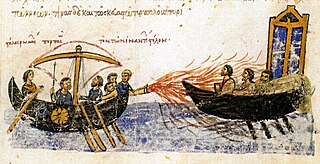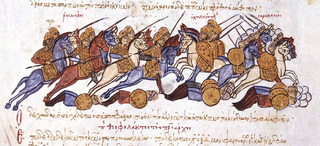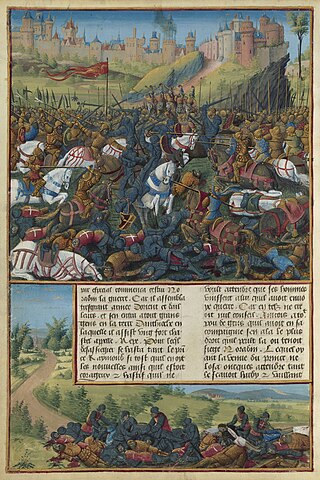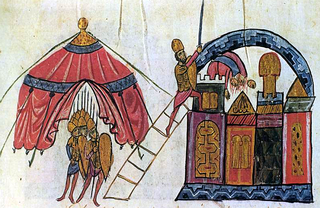 W
WThis is a list of the wars or external conflicts fought during the history of the Eastern Roman or Byzantine Empire (395–1453). For internal conflicts see the list of Byzantine revolts and civil wars.
 W
WThe Arab–Byzantine wars were a series of wars between the mostly Arab Muslims and the Byzantine Empire between the 7th and 11th centuries AD, started during the initial Muslim conquests under the expansionist Rashidun and Umayyad caliphs in the 7th century and continued by their successors until the mid-11th century.
 W
WThe Avar–Byzantine wars were a series of conflicts between the Byzantine Empire and the Avar Khaganate. The conflicts were initiated in 568, after the Avars arrived in Pannonia, and claimed all the former land of the Gepids and Lombards as their own. This led to them attempting to seize the city of Sirmium from Byzantium, which had previously retaken it from the Gepids, without success. Most of their future conflicts came as a result of raids by the Avars, or their subject Slavs, into the Balkan provinces of the Byzantine Empire.
 W
WThe Byzantine reconquest of Cilicia was a series of conflicts and engagements between the forces of the Byzantine Empire under Nikephoros II Phokas and the Hamdanid ruler of Aleppo, Sayf al-Dawla, over control of the region of Cilicia in southeastern Anatolia. Since the Muslim conquests of the 7th century, Cilicia had been a frontier province of the Muslim world and a base for regular raids against the Byzantine provinces in Anatolia. By the middle of the 10th century, the fragmentation of the Abbasid Caliphate and the strengthening of Byzantium under the Macedonian dynasty allowed the Byzantines to gradually take the offensive. Under the soldier-emperor Nikephoros II Phokas, with the help of the general and future emperor John I Tzimiskes, the Byzantines overcame the resistance of Sayf al-Dawla, who had taken control of the former Abbasid borderlands in northern Syria, and launched a series of aggressive campaigns that in 964–965 recaptured Cilicia. The successful conquest opened the way for the recovery of Cyprus and Antioch over the next few years, and the eclipse of the Hamdanids as an independent power in the region.
 W
WBetween 780–1180, the Byzantine Empire and the Abbasid & Fatimid caliphates in the regions of Iraq, Palestine, Syria, Anatolia and Southern Italy fought a series of wars for supremacy in the Eastern Mediterranean. After a period of indecisive and slow border warfare, a string of almost unbroken Byzantine victories in the late 10th and early 11th centuries allowed three Byzantine Emperors, namely Nikephoros II Phokas, John I Tzimiskes and finally Basil II to recapture territory lost to the Muslim conquests in the 7th century Arab–Byzantine wars under the failing Heraclian Dynasty.
 W
WThe First Crusade (1096–1099) was the first of a series of religious wars initiated, supported, and sometimes directed by the Latin Church in the medieval period. The initial objective was the recovery of the Holy Land from Islamic rule. These campaigns were subsequently given the name crusades. The earliest initiative for the First Crusade began in 1095 when the Byzantine Emperor, Alexios I Komnenos, requested military support from the Council of Piacenza in the Byzantine Empire's conflict with the Seljuk-led Turks. This was followed later in the year by the Council of Clermont, during which Pope Urban II supported the Byzantine request for military assistance and also urged faithful Christians to undertake an armed pilgrimage to Jerusalem.
 W
WThe Byzantine–Genoese War of 1348–1349 was fought over control over custom dues through the Bosphorus. The Byzantines attempted to break their dependence for food and maritime commerce on the Genoese merchants of Galata, and also to rebuild their own naval power. Their newly constructed navy however was captured by the Genoese, and a peace agreement was concluded.
 W
WThe Hungarian invasions of Europe took place in the ninth and tenth centuries, the period of transition in the history of Europe in the Early Middle Ages, when the territory of the former Carolingian Empire was threatened by invasion from multiple hostile forces, the Magyars (Hungarians) from the east, the Viking expansion from the north and the Arabs from the south.
 W
WIn 566, Lombard king Alboin concluded a treaty with the Pannonian Avars, to whom he promised the Gepids' land if they defeated them. The Gepids were destroyed by the Avars and Lombards in 567. Gepid King Cunimund was killed by Alboin himself. The Avars subsequently occupied "Gepidia", forming the Avar Khaganate. The Byzantine Emperor intervened and took control of Sirmium, also giving refuge to Gepid leader Usdibad, although the rest of Gepidia was taken by the Avars. Gepid military strength was significantly reduced; according to H. Schutz (2001) many of them joined Lombard ranks, while the rest took to Constantinople. According to R. Collins (2010) the remnants were absorbed either by the Avars or Lombards. Although later Lombard sources claim they had a central role in this war, it is clear from contemporary Byzantine sources that the Avars had the principal role. The Gepids disappeared and the Avars took their place as a Byzantine threat. The Lombards disliked their new neighbours and decided to leave for Italy, forming the Kingdom of the Lombards.
 W
WThe Byzantine–Lombard wars were a protracted series of conflicts which occurred from AD 568 to 750 between the Byzantine Empire and a Germanic tribe known as the Lombards. The wars began primarily because of the imperialistic inclinations of the Lombard king Alboin, as he sought to take possession of Northern Italy. The conflicts ended in a Byzantine defeat, as the Lombards were able to secure large parts of Northern Italy at first, eventually conquering the Exarchate of Ravenna in 750.
 W
WThe Sasanian civil war of 589–591 was a conflict that broke out in 589, due to the great deal of dissatisfaction among the nobles towards the rule of Hormizd IV. The civil war lasted until 591, ending with the overthrow of the Mihranid usurper Bahram Chobin and the restoration of the Sasanian family as the rulers of Iran.
 W
WThe Second Crusade (1147–1150) was the second major crusade launched from Europe. The Second Crusade was started in response to the fall of the County of Edessa in 1144 to the forces of Zengi. The county had been founded during the First Crusade (1096–1099) by King Baldwin I of Jerusalem in 1098. While it was the first Crusader state to be founded, it was also the first to fall.
 W
WThe Siege of Antioch (968–969) was a successful military offensive undertaken by leading commanders of the Byzantine Empire in order to reconquer the strategically important city of Antioch from the Hamdanid Dynasty.
 W
WThe Slavic migrations to the Balkans are considered to have taken place mostly in the first decades of the 7th century in Late antiquity after a series of wars between the Sassanid Empire (Persia) and the Avar Khaganate against the Eastern Roman Empire. Also called the Byzantine Empire, it lost much of its territory in Egypt, the Levant, Asia Minor and the Balkans. Apart from the conflict for territory, these wars religious, with the Zoroastrians and Christians vying for power over Mesopotamia. The backbone of the Avar Khaganate consisted of Slavic tribes, which, after the failed siege of Constantinople in the summer of 626, remained in the wider Balkans after they had settled the Byzantine provinces south of the river Sava and Danube, from the Adriatic toward Aegean up to the Black Sea. Exhausted by wars and reduced to the coastal parts of the Balkans, Byzantium was not able to wage war on two fronts and to regain its lost territories, but it reconciled with the fact of establishing Slavic pagania and created an alliance with them against the Avar Khaganate in Pannonian Basin.
 W
WThe Third Crusade (1189–1192) was an attempt by the leaders of the three most powerful states of Western Christianity to reconquer the Holy Land following the capture of Jerusalem by the Ayyubid sultan Saladin in 1187. It was partially successful, recapturing the important cities of Acre and Jaffa, and reversing most of Saladin's conquests, but it failed to recapture Jerusalem, which was the major aim of the Crusade and its religious focus.
 W
WThe Venetian–Genoese Wars were a series of struggles between the Republic of Genoa and the Republic of Venice, at times allied with other powers, for dominance in the Mediterranean Sea between 1256 and 1381. There were four bouts of open warfare, in which the fighting between the two republics took place largely at sea. Even during periods of peace, incidents of piracy and other minor outbreaks of violence between the two trading communities were commonplace.
 W
WThe Byzantine–Venetian War of 1296–1302 was an offshoot of the second Venetian–Genoese War of 1294–1299.
 W
WOn 31 March, 1146, the French abbot Bernard of Clairvaux preached at Vézelay to encourage support for the Second Crusade.
 W
WThe War of Curzola was fought between the Republic of Venice and the Republic of Genoa due to increasing hostile relations between the two Italian republics. Spurred largely by a need for action following the commercially devastating Fall of Acre, Genoa and Venice were both looking for ways to increase their dominance in the Eastern Mediterranean and Black Sea. Following the expiration of a truce between the republics, Genoese ships continually harassed Venetian merchants in the Aegean Sea.
 W
WThe War of the Sicilian Vespers or just War of the Vespers was a conflict that started with the insurrection of the Sicilian Vespers against Charles of Anjou in 1282 and ended in 1302 with the Peace of Caltabellotta. It was fought in Sicily, Catalonia and elsewhere in the western Mediterranean between the kings of Aragon on one side against the Angevin Charles of Anjou, his son Charles II, the kings of France, and the Papacy on the other side. The war resulted in the division of the old Kingdom of Sicily; at Caltabellotta, Charles II was confirmed as king of Sicily's peninsular territories, while Frederick III was confirmed as king of the island territories.